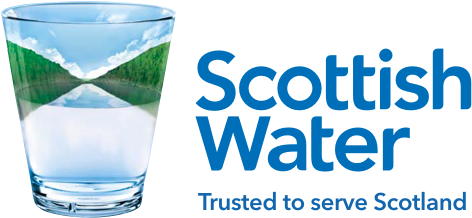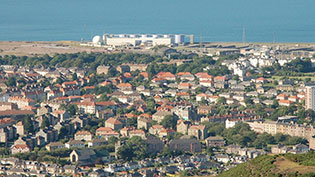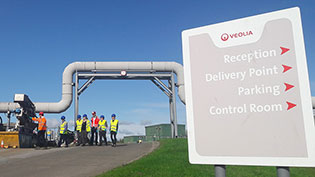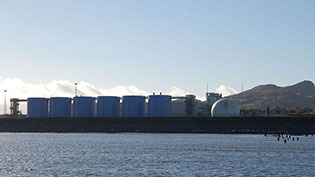Operational Update
This report looks at activity undertaken since the start of the current calendar year. Despite the obvious impacts from the emergence of the COVID-19 pandemic, we would like to reassure our customers that throughout this period Seafield Waste Water Treatment Works (WWTW) has continued to provide a full service on a 24/7 basis. Seafield, as with all wastewater treatment sites, is part of the unseen critical infrastructure that serves our communities. The management team from Scottish Water and Veolia would like to thank the key workers in both organisations for their dedication and commitment to keep key services running during these challenging times.
Odour minimisation
While treating waste water/sewage will always present challenges in relation to managing odour, it will always be a priority to reduce and minimise the effects of this on nearby communities.
At Seafield, every effort is made to ensure that odour sensitive tasks or planned maintenance work is undertaken at a time when it would impact least on the community.
However, as identified in the independent Strategic Odour Review (March 2018), there can be occasions when operational and climatic conditions combine and it becomes very difficult to prevent or limit odours, particularly from the primary settlement stage. Such circumstances have materialised and we are aware that an odour impact was felt in some parts of the community, over the last few months, despite the site operating normally, with site conditions and sludge levels within targets. Thanks to the good descriptive comments in complaints generated through the Leith Links Community Council app during the week of the 15th of June, we were able to assist and identify an additional source of odour north of the Links. Unfortunately there was a further increase in complaints during the week of the 22nd of June which was linked with the cleaning of a primary settlement tank and Veolia would like to apologise to all stakeholders for the odour issues experienced during that activity.
Tackling these specific odour events is one of the key priorities in the long-term investment plan that Scottish Water is currently working on. We will be consulting with residents on these plans as part of the investment process.
Energy production
In keeping with circular economy principles, Seafield generates electricity from the biogas that occurs naturally during the treatment processes on site.
On average, the site is able to self-generate between 80-90% of its total energy needs throughout the year.
Generating and reusing energy on site, leads to significant carbon savings which will help us meet our ambitious net zero emissions targets.
Odour control through network treatment
One of the recommendations made in the independent Strategic Odour Review was the use of chemical treatment within the sewer network. The use of odour reducing agents was successfully trialled in May 2018 in a study undertaken by Scottish Water, developed by Cranfield University and overseen by the Wood Group. Since then, when required, network dosing has been undertaken by Scottish Water as it arrives at Seafield. This helps to alleviate odour impacts caused by the natural generation of hydrogen sulphide within the sewerage network.
Further chemical addition is also carried out as required at Prestonpans and at the Wallyford Pumping Station which has the benefit of treating sewage in the sewer network before it arrives at the treatment works.
Biosolids
On average, each year the site produces about 30,000 tonnes of an enhanced treated biosolid fertiliser product that can be used by farmers in agriculture. Thus far in 2020, the site has already produced about 10,000 tonnes and is well on course to meet projected targets. The fertiliser is a natural product and can be used by farmers in place of manufactured chemical treatments. Reducing the use of chemical fertilisers has significant benefits to the environment.
Improvements to the working environment
From late 2019 into this year, Veolia has made significant investment to improve the working environment at Seafield. This has included a substantial refurbishment of the operational and control room areas. As well as providing a better working environment for staff, the changes promote a shared and collaborative work space and bring together team members from different operational areas. This helps ensure that staff are able to respond quickly and effectively to deal with any issues that might affect customers within the community.
Aeration upgrades
One of the most energy intensive parts of the treatment process is the aeration tanks, where oxygen is pumped under pressure into the sewage in order to encourage friendly bacteria to break down solid organic material. Veolia has made a significant investment into this part of the site and has replaced one of the blower units, with the other earmarked for replacement later this year. The new blower units are more efficient and quieter. As well as the main blower units, Veolia is replacing all the air diffusers in the tanks.
These investments will reduce energy usage, which has positive impacts on the environment and will minimise noise from this part of the site.
Tackling noise
While investigating a recent noise complaint, Veolia identified a possible issue in one of the primary settlement tank compressors which may have been causing an intermittent noise, detectable within the community during onshore winds. This tank will therefore be taken out of service.
As part of the ongoing commitment by Veolia to reduce noise nuisance, an acoustic engineering firm has been appointed to carry out a full acoustic assessment of the site which is due to progress shortly.
Early investigations have identified that the primary tank compressors (which operate intermittently) may be delivering too much air, and this could be impacting on the noise generated. If confirmed, the solution to deal with this would be the purchasing of a variable speed drive motor which will allow air flow rates to be adjusted. This could be supplemented with an in-line silencer. Trials will be in place by July (if this is the case).
There have been occasional noise complaints and we hope that the work Veolia is doing can provide reassurance that complaints are being investigated and addressed in a way that seeks to improve site operations.
Digester care
As part of planned, proactive maintenance, Veolia is currently undertaking a cleaning and optimisation routine in the digester area at Seafield. This will lead to reduced odour risks by minimising downtime of the digester equipment.
Odour Control Unit Maintenance
In order to maintain efficiency, one of the odour control units is due to be replaced this year. This represents a £240,000 investment by Veolia in planned maintenance.
Long sea outfall
As part of the preventative maintenance programme, work will be undertaken this year to fully inspect the long sea outfall. This involves the use of a specialist diving team that will inspect the 1.1 mile outfall that is used to release the final treated effluent from Seafield out into the Firth of Forth. Taking preventative maintenance measures will ensure that the outfall continues to operate at full efficiency, which will reduce the likelihood of any impacts an issue would cause within the treatment works.








